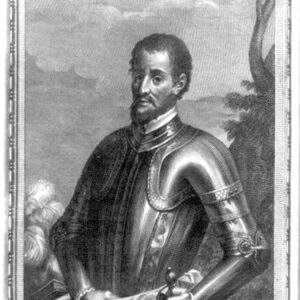calsfoundation@cals.org
Spanish Explorers and Settlers
The only Spanish expedition into present-day Arkansas began when Hernando de Soto led his party across the Mississippi River on June 18, 1541. The Spaniards had already endured two years of wandering throughout the American southeast, hoping to duplicate the conquest and colonization of a wealthy and powerful nation, as had been done twenty years earlier with the Aztecs of Mexico. De Soto’s band of fortune seekers trudged on for another two years after crossing into Arkansas, where they encountered many large, agriculturally prosperous native chiefdoms, but none of the gold or silver that they sought. By the end of the expedition, approximately half their number, including de Soto himself, had died from sickness, hunger, exposure, or conflict with the natives. The survivors escaped to Spanish territory in Mexico with nothing more than their lives.
A reasonably accurate composite of de Soto and his party may be constructed from three primary sources and one secondary source that documented the expedition, but it is difficult to pinpoint exactly where it went. The Spanish mostly concerned themselves with discovering gold or silver and supplying their needs by whatever means necessary. To this end, the Spanish frequently pillaged stores of food, utilized their military strength to frighten locals into meeting their demands, and forced captured natives into slavery. They had only a casual interest in recording information about any natives they encountered or the country in which they lived. Archeologists have been able to identify some details left unaddressed by the written sources, thus permitting historians to piece together the most plausible route traveled by de Soto.
After crossing the Mississippi River, the Spanish remained hopeful that gold could yet be discovered in the mountainous area of northern Arkansas, so de Soto marched the expedition to the northwest, then due west. They advanced far into western Arkansas, but elected to turn back to the southeast after encountering bitter resistance from the fierce Tula people, somewhere in the vicinity of present-day Fort Smith (Sebastian County), in early October. By the following spring, de Soto had reached the provinces of Anilco—a village along the Arkansas River that may have included the Menard-Hodges Site—and Guachoya near the Mississippi River (likely in present-day Chicot County), where he planned to dispatch ships to Mexico and Cuba to give word of his whereabouts, and to resupply his expedition.
While stationed at Guachoya, de Soto contracted a fever and died on May 21, 1542. The people of Guachoya were aware that de Soto had been sick, and suspected that he had died. The Spanish explained his sudden absence by saying that he had ascended back into the heavens, as de Soto had promoted his own status among the natives as an immortal “son of the Sun,” gifted with supernatural powers. The Spanish feared that the body would be desecrated by the natives if discovered, so they placed it inside a hollow oak tree, weighed it down with sand, and sank the tree in the Mississippi River.
Some of the Spaniards still held out hope of discovering riches if they continued on, but the consensus of the expedition was to abandon their quest and return to Spanish territory. Luis de Moscoso Alvarado, whom de Soto had appointed as his successor, resolved to reach Mexico by land, and began their march to the southwest.
As the Spanish crossed into what is now Texas, they encountered hunter-gatherer peoples with increasingly scarce supplies of corn available for plunder. Moscoso became convinced that with no food, no translators, and no idea how much farther it was to Mexico, their only viable course was to turn back the way they had already come. The expedition reached Anilco by December but found no supply of food there, so they settled for the winter in the neighboring chiefdom of Aminoya (possibly in southern Phillips County). Here they spent the next several months constructing ships for their journey down the Mississippi River. Native warriors from several chiefdoms pursued the Spanish after they set sail, harassing them all the way to the sea. The expedition reached the Gulf of Mexico after nineteen days, then continued southwest along the coast until the survivors finally reached a Spanish settlement at the mouth of the Panuco River in Mexico on September 10, 1543.
Forty years of Spanish rule over present-day Arkansas began in 1762, when ownership of the Louisiana Territory passed from the French to the Spanish. During this time, the Spanish were constantly wary of foreign excursions into their territory (either British encroachment from Canada or gradual westward expansion from the young United States), so they governed the region from a defensive posture. Their governors wanted to permit only immigrants who would not jeopardize Spanish control over the colony, such as Spaniards or other European Catholics, but these proposals received only a tepid response from the authorities in Spain and were insufficient to halt the steady flood of Americans that were making their way into the territory. Apart from the government agents and soldiers who were assigned to go there, just a handful of Spanish migrants ever came to Arkansas.
The Spanish did make one attempt at establishing a settlement of their own within Arkansas. It began in 1783, when Commandant Don Juan Filhiol was ordered to establish an outpost as far north as was feasible along the Ouachita River, to protect lower Louisiana from roving bands of Osage warriors. Filhiol established a trading post at Ecore a Fabri, on a bluff overlooking the Ouachita at present-day Camden (Ouachita County), but he was unsuccessful in attracting settlers to move there and abandoned the bluff two years after his arrival. He moved south and successfully reestablished his post near the confluence of Bayou Bartholomew and the Ouachita River, at present-day Monroe, Louisiana.
A settlement named Hopefield (Crittenden County) did eventually grow around Campo de la Esperanza (“Field of Hope”), a small Spanish fort built in 1797 across from present-day Memphis, Tennessee. The outpost, which housed four sailors and eight soldiers, was established to collect tariffs and monitor traffic along the Mississippi River, but its evolution into an actual town did not occur until after Arkansas had become part of the United States. The only true European settlement in Spanish Arkansas was Arkansas Post, which had been founded by the French in 1686, but it did prosper during the Spanish period and attracted a fair number of European and American immigrants.
For additional information:
Arnold, Morris S. “The Significance of the Arkansas Colonial Experience.” Arkansas Historical Quarterly 51, no. 1 (Spring 1992): 69–82.
———. Unequal Laws unto a Savage Race: European Legal Traditions in Arkansas, 1686–1836. Fayetteville: University of Arkansas Press, 1985.
Arnold, Morris S., and Dorothy Jones Core. Arkansas Colonials: A Collection of French and Spanish Records Listing Early Europeans in Arkansas, 1673–1804. DeWitt, AR: Grand Prairie Historical Society, 1986.
Dickinson, Samuel Dorris. “Don Juan Filhiol at Ecore a Fabri.” Arkansas Historical Quarterly 46 (Summer 1987): 133–155.
Din, Gilbert C. “The First Spanish Instructions for Arkansas Post, November 15, 1769.” Arkansas Historical Quarterly 53 (Autumn 1994): 312–319.
———. “Spain’s Immigration Policy in Louisiana and the American Penetration, 1792–1803.” Southwestern Historical Quarterly 76 (January 1973): 255–276.
DuVal, Kathleen. “The Education of Fernando de Leyba: Quapaws and Spaniards on the Border of Empires.” Arkansas Historical Quarterly 60 (Spring 2001): 1–29.
Gonzalez Lopez-Briones, M. Carmen. “Spain in the Mississippi Valley: Spanish Arkansas, 1762–1804.” PhD diss., Purdue University, 1983. Online at https://docs.lib.purdue.edu/dissertations/AAI8407540/ (accessed July 5, 2022).
Herndon, Dallas T. Annals of Arkansas. Little Rock: Historical Records Association, 1947.
Hudson, Charles M. Knights of Spain, Warriors of the Sun: Hernando de Soto and the South’s Ancient Chiefdoms. Athens: University of Georgia Press, 1997.
Sjostrom, Kristine L. Fernando de Leyba (1734–1780): A Life of Service and Sacrifice. Seville: 2022.
Sloan, David. “The Expedition of Hernando de Soto: A Post-Mortem Report.” Arkansas Historical Quarterly 51 (Spring 1992): 1–29.
———. “The Expedition of Hernando de Soto: A Post-Mortem Report, Part II.” Arkansas Historical Quarterly 51 (Winter 1992): 297–327.
Adam Miller
Austin, Texas
 European Exploration and Settlement, 1541 through 1802
European Exploration and Settlement, 1541 through 1802 Louisiana Purchase through Early Statehood, 1803 through 1860
Louisiana Purchase through Early Statehood, 1803 through 1860 Spanish Land Grants
Spanish Land Grants Hernando de Soto
Hernando de Soto 




Comments
No comments on this entry yet.